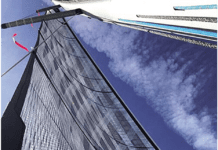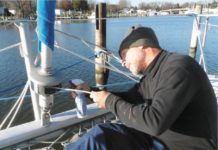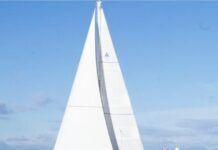Ericson 32
A look at both the 1969 and 1985 designs by Bruce King finds more to like about the later model boat.
UWB 333
The arithmetic of weights and displacements prevents us from ever realizing a trailerable boat that will sail at the preferred half-submerged condition of our hypothetical craft. But you can get a trailerable hull by this scheme that will sail about one-third submerged, which probably is close enough, and that boat will have more than enough righting moment for reasonable sail-carrying. You also can get a boat that weighs relatively little out of the water compared to its displacement in the water--exactly the characteristic you want in a blue-water trailer sailer. I describe this design as "Ultra Water Ballasted."
Catalina 34
It doesn't take a lot of brains to see that Catalina is doing something right that a lot of other sailboat makers aren't. They're the largest sailboat builder in the country, and a terrible year for them would be Valhalla for almost every other manufacturer. With more than 1,000 built in seven years, the Catalina 34 has to be in the running as the most successful production boat of the 1980s.
Tartan 34
More than 500 Tartan 34s were built between 1968 and 1978. By 1978 the CCA rule was long gone, PHRF racing was beginning to surge, and the MHS (now IMS) was in its infancy. The Tartan 34 had passed from a racer/cruiser to a cruiser, not because the boat had changed, but because sailboat racing had changed. The Tartan 34 was succeeded by the larger, more modern Tartan 37, a boat of exactly the same concept.
Tartan 33
In 1978, Tartan brought out the Tartan Ten, a 33', fairly light, fractionally-rigged "offshore one design." The boat was a huge success: fast, easy to sail, and unencumbered by the design limitations of a rating rule. But the Tartan Ten had one big problem: limited accommodations with stooping headroom, an interior most kindly described as spartan. A hardy crew could take the Tartan Ten on a multi-day race such as the Mackinac, and you might even coax your family aboard for a weekend of camping out. But cruising or extended racing in comfort? Forget it!
Contest 35S
Conyplex, builder of the Contest 35S, is an established company that was a pioneer in fiberglass boat construction. In 1958, it began work on fiberglass Flying Dutchmans, and two years later introduced the Contest 25, its first cruiser. More than 5,000 boats have been built since, with about 600 of these being exported to the U.S. through Van Breems Holland Yachts of Westport, Connecticut.
Pearson 35
The Pearson 35 was introduced in 1968 and remained in production for the next 14 years. In all, 514 P35s were built, almost all for East Coast and Great Lakes owners attracted by the 35's shoal draft (3' 9" with centerboard up) and "classic" proportions. Even the popular Pearson 30, usually heralded as the enduring boat from a builder otherwise noted for its frequent introductions of new boats and short production runs, remained in production only 10 years, albeit with almost 1,200 boats built.
Nicholson 35
Just over 200 Nicholson 35s were built over more than a 10-year period, with production tailing off in the early 1980s. Most boats were sold in England, but a number were built for American owners, and still more found their way to the U.S. during the rampage of the dollar against foreign currencies in the mid 1980s. The Nicholson 35 is a cruising boat, plain and simple. Its proportions are about as common-sense and moderate as you can get. The boat is clean, almost austere in appearance, with very little exterior wood trim.
Niagara 31/35
Best known for his big race boats, Argentinean designer German Frers drew the lines of the Niagara 31. The 35, as noted, was drawn by Mark Ellis, who also designed the Nonsuch line, and more recently, the Northeast 37 motorsailer. The 35 came first, in 1978, and about 300 were built before its run came to an end in 1995. The Niagara 31 was built between 1980 and 1984. A less popular 26-footer also was built, as well as a 42.
Morgan 34
By today's standards, the Morgan 34 is a small boat, comparable in accommodations to a lot of 30-footers. When the boat was designed, she was as big as most other boats of her overall length. In profile, the boat has a sweeping, moderately concave sheer. The ends of the boat are beautifully balanced: the bow profile is a slight convex curve, the overhanging counter aft is slightly concave. Esthetically, hull shapes of this period from the best designers are still hard to beat.











































